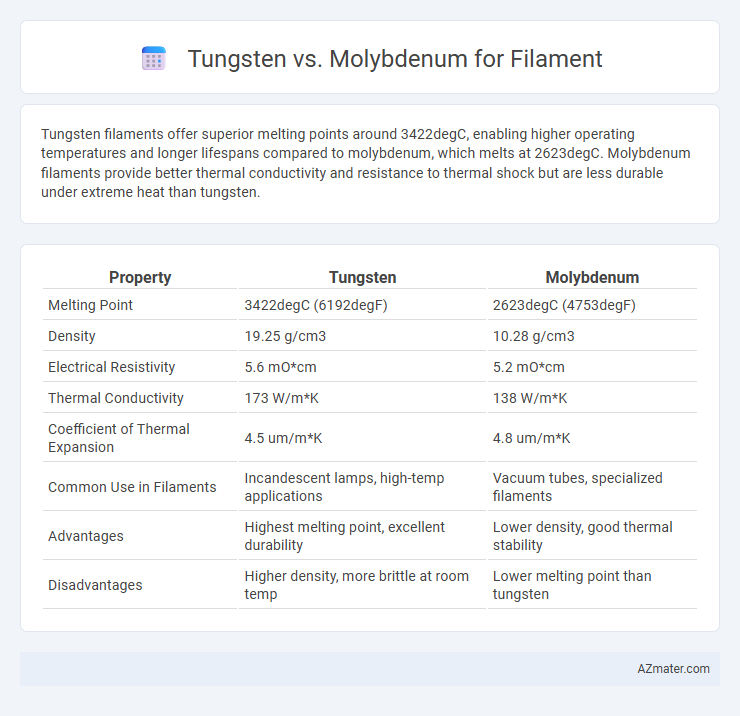Tungsten filaments offer superior melting points around 3422degC, enabling higher operating temperatures and longer lifespans compared to molybdenum, which melts at 2623degC. Molybdenum filaments provide better thermal conductivity and resistance to thermal shock but are less durable under extreme heat than tungsten.
Table of Comparison
| Property | Tungsten | Molybdenum |
|---|---|---|
| Melting Point | 3422degC (6192degF) | 2623degC (4753degF) |
| Density | 19.25 g/cm3 | 10.28 g/cm3 |
| Electrical Resistivity | 5.6 mO*cm | 5.2 mO*cm |
| Thermal Conductivity | 173 W/m*K | 138 W/m*K |
| Coefficient of Thermal Expansion | 4.5 um/m*K | 4.8 um/m*K |
| Common Use in Filaments | Incandescent lamps, high-temp applications | Vacuum tubes, specialized filaments |
| Advantages | Highest melting point, excellent durability | Lower density, good thermal stability |
| Disadvantages | Higher density, more brittle at room temp | Lower melting point than tungsten |
Introduction to Tungsten and Molybdenum Filaments
Tungsten filaments, known for their exceptional melting point of 3422degC and high tensile strength, dominate incandescent lamp technology due to their superior durability and efficient light emission. Molybdenum filaments, with a melting point of 2623degC and excellent thermal conductivity, are often used in specialized applications requiring resistance to oxidation and stability under high temperatures. Both metals offer unique advantages in filament design, balancing performance factors such as heat resistance, electrical conductivity, and longevity for tailored lighting solutions.
Chemical and Physical Properties Comparison
Tungsten has a higher melting point of 3422degC compared to molybdenum's 2623degC, making it more suitable for filament applications requiring extreme heat resistance. Chemically, tungsten exhibits greater oxidation resistance at high temperatures, enhancing filament longevity in incandescent bulbs. Physically, tungsten's superior tensile strength and lower thermal expansion reduce deformation and sagging during operation, outperforming molybdenum under intense thermal stress.
Melting Points and Temperature Resistance
Tungsten offers a higher melting point of approximately 3422degC, making it ideal for filament applications requiring superior temperature resistance compared to molybdenum, which melts at 2623degC. The elevated melting point of tungsten ensures better durability and performance in high-temperature environments such as incandescent light bulbs and electron emitters. Molybdenum, while less heat resistant, provides advantages in thermal conductivity and oxidation resistance, but is typically limited to lower-temperature filament uses.
Electrical Conductivity of Tungsten vs Molybdenum
Tungsten exhibits lower electrical conductivity compared to molybdenum, with tungsten typically around 18.2% IACS (International Annealed Copper Standard) and molybdenum approximately 34% IACS, making molybdenum more efficient in conducting electricity. Despite this, tungsten's high melting point (3422degC) and superior mechanical strength sustain its dominance in filament applications where durability under extreme temperatures is critical. Molybdenum's higher electrical conductivity offers advantages in applications requiring better current flow but is limited by its lower melting point (2623degC) relative to tungsten.
Mechanical Strength and Durability
Tungsten filaments exhibit superior mechanical strength with a melting point of 3422degC, making them highly durable under extreme temperatures and mechanical stress. Molybdenum filaments, while having lower melting point (2623degC), offer good mechanical strength and enhanced resistance to oxidation, extending their operational lifespan in specific applications. The choice between tungsten and molybdenum filaments depends on the desired balance of thermal durability and mechanical resilience in high-temperature environments.
Performance in High Vacuum Environments
Tungsten offers superior performance as a filament material in high vacuum environments due to its exceptionally high melting point of 3422degC and excellent thermal stability, reducing evaporation rates and extending filament lifespan. Molybdenum, with a melting point of 2623degC, exhibits lower thermal endurance and higher vapor pressure under vacuum conditions, leading to faster degradation and shorter operational life in similar settings. Tungsten's enhanced electron emission properties and resistance to sputtering make it the preferred filament choice for high vacuum applications such as electron microscopy and vacuum tube technology.
Cost and Availability Factors
Tungsten filaments are more expensive due to higher raw material costs and complex manufacturing processes compared to molybdenum. Molybdenum offers a cost-effective alternative with greater availability and easier production, making it favorable for budget-sensitive applications. Supply chain stability favors molybdenum, as tungsten has limited global reserves and concentrated mining regions, impacting price volatility.
Common Applications in Lighting and Electronics
Tungsten filaments dominate in traditional incandescent lighting due to their high melting point of 3422degC and excellent thermal stability, enabling long-lasting, bright light sources. Molybdenum filaments are preferred in specialized electronic applications and vacuum tubes where lower evaporation rates and superior electrical conductivity at high temperatures are crucial. Both metals are integral to lighting and electronics, with tungsten excelling in household bulbs and molybdenum favored in high-performance, industrial, and scientific devices.
Advantages and Disadvantages of Each Material
Tungsten filaments offer superior melting points around 3422degC, providing high durability and excellent performance in high-temperature environments, but they are brittle and prone to oxidation without a protective atmosphere. Molybdenum filaments, with melting points near 2623degC, exhibit better thermal shock resistance and flexibility while being less expensive, though they have lower maximum operating temperatures and higher oxidation rates compared to tungsten. Choosing between tungsten and molybdenum depends on specific application requirements, balancing thermal endurance, mechanical robustness, and cost-effectiveness.
Conclusion: Choosing the Right Filament Material
Tungsten offers superior melting point (3422degC) and excellent mechanical strength, making it ideal for high-temperature filament applications requiring durability and longevity. Molybdenum, with a lower melting point (2623degC) and good thermal conductivity, is better suited for moderate temperature applications where cost and thermal efficiency are prioritized. Selecting between tungsten and molybdenum filaments depends on balancing operating temperature demands, mechanical stability, and budget constraints for optimal performance.

Infographic: Tungsten vs Molybdenum for Filament
 azmater.com
azmater.com